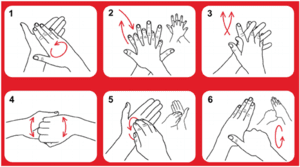Hands Hygiene
Washing hands is the most important act in disease prevention because your hands are in direct contact with the patient’s body and even with patient’s body fluid. Every day we are in touch with thousands of microorganism. Washing hands seem simple at first glance but a recent study has shown that in 79% of the times this act is done wrongly. A recent study showed that just 5% of the people wash their hands correctly.
What is the correct way of washing hands?

- Soak your hands with mild water. Apply a palmful of the product in a cupped hand, covering all surfaces. Rub hands palm to palm;
- Wash the spaces between the fingers. Right palm over left dorsum with interlaced fingers and vice versa;
- Palm to palm with fingers interlaced; Lock the fingers together and scrub the back of the finger and nail with a scrub on the palm. If your hands are so dirty, wash your nails one by one.
- Clean your fingertips by rubbing them against the palm of other hand. Backs of fingers to opposing palms
- Rotational rubbing, backwards and forwards with clasped fingers of right hand in left palm and vice versa;
- Rub left thumb clasped in right palm and vice versa;
Go through all the phases in the specific order and give enough time (20 to 30 seconds) for each phase.
When should we wash our hands?
- Before contact with the patient
- After contact with the patient
- Before cleaning and spastic procedure
- After contact with the patient’s surroundings
- After contact with the patient’s blood and discharge
- Before, after and while you are cooking
- Before and after eating food
- Before and after caring the patients
- After going to the toilet
- After contact of hands and waste and plastic filled with garbage
- After returning home
- Healing the patients as soon as possible is from God Almighty
References: National Guide to Infection Control




